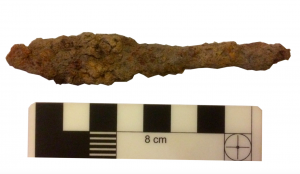Archaeologists uncovered new artefacts at the site of the Viking winter camp at Repton, Derbyshire, United Kingdom, dating back to the 870s.

According to the Anglo-Saxon Chronicle, the Great Army moved to Repton in 873, driving the Mercian king Burghred from his kingdom. Repton was partly chosen because of its location on the River Trent, but also due to a monastery that housed the remains of several Mercian kings. The Viking camp has been known since the 1970s, but now the archaeologists unearthed the area that was previously surveyed with non-invasive methods, including a ground penetrating radar. In 1975, archaeologists uncovered a D-shaped enclosure measuring 1.5 hectares on the banks of the river, believed to be the Viking camp. The camp covers a much larger area that once presumed. The GPR survey revealed evidence for workshops and ship repairs over a much larger area. A team from the University of Bristol also discovered structures, dating from the winter of 873-874, such as paths and possible temporary buildings in form of gravel platforms that may have held temporary timber structures or tents. Archaeologists also uncovered fragments of Saxon millstones and a cross fragment from the monastery, broken pieces of weaponry including fragments of battle-axes and arrows, and also evidence for metal working as well as a substantial number of nails. Two of the nails had roves, a particular feature of Viking ship nails, as well as several lead gaming pieces. The research also confirmed that a grave of almost 300 people fits a date of 873, and is consistent with the remains being Viking war dead.

(after Yahoo News & PA)